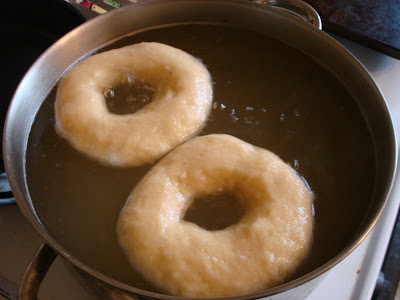The Scene
Ah, bagels. Ranking behind pizza and before cheese steaks in the top three of most controversial foods, the debate over what constitutes a perfect bagel can lead to heated arguments, assault, and even divorce.
 |
| "Whole-wheat pumpkin cranberry? I don't think this is gonna work." |
This may be a result of the fact that the true origin of the bagel is a complete mystery, like the statues on Easter Island and Gary Busey.
 |
| It was Monsanto |
According to
Wikipedia and other sources, the bagel was first made by the Polish, the Austrians, the Russians or the Uyghurs of China at some unknown point of time. It may be related to the pretzel, the bialy, the bublik, the vesirinkili, the simit, or any other one of a number of regional breads that are boiled and/or circle shaped. In other words, no one freakin' knows. What we do know is that at some point, whether by accident or by choice, someone decided to boil a doughnut and Jews worldwide yelled out with a collective "Mekheye!".
 |
| Just like this |
In North America, we have three distinct styles of bagel. There is the New York bagel which is made by boiling the dough before baking it and results in a dense and chewy smaller bagel. There is the not-New York style that is steamed before baking instead of being boiled and results in a larger bagel that has a lighter, more bread-like crumb. This is the type that you will usually find in places like Noah's Bagels here in California. There is also the Montreal style that has significant sugar added to the dough and is boiled in honey water, cause, well...
 |
| That's why |
The recipe in the BBA book is for the New York style boiled bagels and I made a batch half with a poppy seed topping and half with asiago cheese. I have actually made this recipe quite a few times before, and years ago I was a baker at a Noah's bagels across the street from the Pacific Stock Exchange in San Francisco. I have made lots of bagels. Thousands. They're in my nightmares. Anyway, this job is what got me into baking, and also what got me into my job with an options clearing firm at the exchange (the hiring manager recruited me because he liked my bagels), but that's a whole other story...
Recipe Deviations & Issues
I made no changes to the recipe whatsoever. It's a really good recipe. The only problem I had was in that I should have probably let the dough proof a bit longer. The bagels were a little bit on the flat side, though this was more of a cosmetic issue and didn't affect them in any way.
Final Results
Bagels! They were bagels, and they good. Dense and chewy, and you could easily peel the crust off like a skin which is a "true" bagel test according to some. As usual, the entire batch was mowed down by the various friends and housemates that were lucky enough to be around. I'm happy that I managed to hide a few to save for lox and cream cheese later.
Make Your Own
And you should make your own! They are much easier than you might expect, and there is nothing like eating one that is still warm from the oven. I have tried the following recipe and it gives very solid results. When making bagels I highly recommend hunting down malt powder, even if the recipe gives alternate sugar choices. The malt is traditional and gives it a richness that you can't replicate with anything else. I have tried.
Click here for bagel recipe at thefreshloaf.com
Up next, Brioche. It'll be a butter party!













